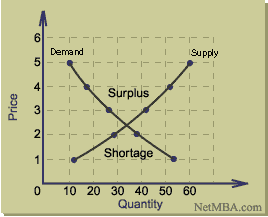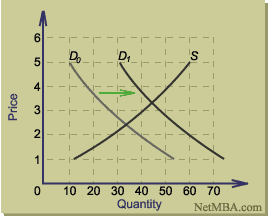 |
| Gas Prices, Lewiston, Maine, 2008 |
Focus Question: How do prices impact buyers and sellers?
Topics on the Page
Price Signals
Supply and Demand
Reservation Prices
Price Fixing
Free Price vs. Fixed Price
Price Signals
Market economies are dependent on price signals to correctly allocate scarce resources. These scarce resources should command higher prices. Resource users will use scarce resources with higher prices for only higher- valued purposes. Resource users will also use abundant resources with lower prices for lower- valued purposes. Both situations are only if they are guided by correct price signals. In the event that price signals are absent or incorrect, then that would lead to wasted resources by using scarce resources for lower- valued purposes and leaving abundant resources underutilized.
Here is a gasoline as a price signal example. The market (and not the government) determines the price of gasoline and the quantity produced/ consumed after a natural disaster in a market- based economic system. Price signals function so that they can prevent mass shortages and surpluses, and also to make sure consumers are satisfied. The price of gasoline provides an incentive to buyers and sellers. In the case of a natural disaster, gasoline prices would rise because of a disruption in supplies. Higher prices would signal to buyers to reduce their consumption, and to sellers to increase their production. In this way, price signals allow markets to function efficiently.
 This podcast from 'econlowdown' describes the essentials on 'Price Signals'
This podcast from 'econlowdown' describes the essentials on 'Price Signals'
 Watch this video for an overview of market efficiency and price signals from Crash Course.
Watch this video for an overview of market efficiency and price signals from Crash Course.
Supply and Demand
The market price of a good is determined by both the supply and demand for it.
- In 1890, English economist Alfred Marshall published his work, which was one of the earlier writings on how both supply and demand interacted to determine price.
- Click here to explore Marshall's Principles of Economics from the Library of Economics and Liberty.
- Today, the supply-demand model is one of the fundamental concepts of economics. The price level of a good is determined by the point at which the quantity supplied equals the quantity demanded.

On the example to the right, there is only one price level at which quantity demanded is in balance with the quantity supplied, and that price is the point at which the supply and demand curves cross which is known as the equilibrium point.
The law of supply and demand predicts that the price level will move toward the point that equalizes quantities supplied and demanded. To understand why this must be the equilibrium point, consider the situation in which the price is higher than the price at which the curves cross. In such a case, the quantity supplied would be greater than the quantity demanded and there would be a surplus of the good on the market.

In the graph to the right, the positive shift in demand results in a new supply-demand equilibrium point that in higher in both quantity and price. For each possible shift in the supply or demand curve, a similar graph can be constructed showing the effect on equilibrium price and quantity. The following table summarizes the results that would occur from shifts in supply, demand, and combinations of the two.
Result of Shifts in Supply and Demand
Demand
|
Supply
|
Equilibrium
Price
|
Equilibrium
Quantity
|
+
|
|
+
|
+
|
-
|
|
-
|
-
|
|
+
|
-
|
+
|
|
-
|
+
|
-
|
+
|
+
|
?
|
+
|
-
|
-
|
?
|
-
|
+
|
-
|
+
|
?
|
-
|
+
|
-
|
?
|
- In the above table, "+" represents an increase, "-" represents a decrease, a blank represents no change, and a question mark indicates that the net change cannot be determined without knowing the magnitude of the shift in supply and demand.
- These shifts in market equilibrium can have a ripple effect on economic markets. These shifts create externalities (unintended consequences that effect the general population).
- Click here to read about the externalities that are produced by a drop in oil prices.
For a different perspective, see Using Maths to Find Equilibrium Price and Quantity
This is information from a Supply and Demand Lecture
Click here for an example of how economists use price signals as economic indicators.
Click here for more information on supply and demand, and the concept of market equilibrium from Khan Academy
Click here for a lesson plan using toy fads to explain supply and demand from EconEdLink.
Introduction to supply and demand from Investopedia: https://www.investopedia.com/articles/economics/11/intro-supply-demand.asp
Reservation Prices
Definition: Basically, reservation prices are limits on the prices of goods and services.
- potential buyer or consumer= maximum value buyer is willing to pay in order to buy a good
- An example of this would be some grocery shoppers not buying an item after looking at the price, some hesitating before buying/ putting it down, and some happily buying the goods.
- potential seller or producer= minimum value seller is willing to accept in order to sell a good
Here is a PowerPoint presentation from the University of California Santa Barbara.
For information on reservation prices for buyers and sellers, see Tutorial 2: Reservation Prices from a course at Illinois State University.
This is a glossary definition of Reservation Prices and short video explaining the word.
Price Fixing
Price fixing is an agreement (written, verbal, or inferred from conduct) among competitors that raises, lowers, or stabilizes prices or competitive terms.

Here is a definition of price fixing from the Federal Trade Commission.
Antitrust laws make it a requirement that companies establish prices/ other terms on their own without agreeing with a competitor. Consumers expect prices have been determined on the basis of supply and demand instead of agreements among competitors when said consumers make choices about what products and services to buy. Strict competition results in higher prices when competitors agree to restrict competition. A major concern of government antitrust enforcement is price fixing.
There are legality issues to consider. Regardless of whether prices are fixed at a minimum, maximum, or within some range, plain agreements among competitors engaging in price fixing is almost always illegal. Illegal price fixing happens when two or more competitors take actions that have the effect of raising, lowering, or stabilizing the price of any product/ service without legitimate justification.
 Sherman Anti-Trust Act (1890)
Sherman Anti-Trust Act (1890)
Investopedia on Price Fixing: https://www.investopedia.com/terms/p/pricefixing.asp
Free Price system vs. Fixed Price System
Wikipedia page on Price systems: https://en.wikipedia.org/wiki/Price_system
Pros and Cons of a Free Price system: https://www.jagranjosh.com/articles/free-price-system-pros-cons-1456382867-1
This article from the New York Times describes the relationship between family structures, gender, and class in regards to price signals
 Learning Plan from PBSTeachers: US Agricultural Subsidies and Nutrition
Learning Plan from PBSTeachers: US Agricultural Subsidies and Nutrition
"This lesson plan utilizes the film and POV’s website resources for Food, Inc., a documentary that examines food in the United States and the industry that produces it.
Classrooms can use these materials to investigate how agricultural subsidies influence food choices, health and the economy."
Addresses the concept of prices and interaction of supply and demand in a market economy as well as the role of the government, producers and consumers
Comments (0)
You don't have permission to comment on this page.